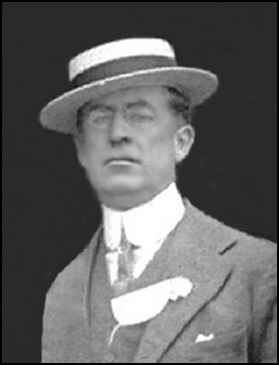
 |
Millard F. Harmon Library of Congress Collection, 8-11-10 |
|
The Army wasted no time in establishing a new airfield. Sergeant Charles E. Garlick, who had landed at Alessandro Field in a "Jenny" in November, 1917, was selected to lead the advance contingent of four men to the new base from Rockwell Field. On February 26, 1918, Garlick and his crew and a group of mule skinners from nearby Colton, known to be experts in clearing land as well as for their colorful syntax, began the task of excavating the building foundations at Alessandro. On March 20, 1918, Alessandro Flying Training Field became March Field, named in honor of Second Lieutenant Peyton C. March, Jr., son of the Army Chief of Staff, who had been killed in a flying accident in Texas the previous month. By late April, 1918, enough progress had been made in the construction of the new field to allow the arrival of the first troops. The commander of the 818 Aero Squadron detachment, Captain William Carruthers, took over as the field's first commander and for a time operated out of an office in the Mission Inn. Within a record 60 days the grain stubble-covered plain of Moreno Valley had been partially transformed to include 12 hangers, six barracks equipped for 150 men each, mess halls, a machine shop, a post exchange, a hospital, a supply depot, an aero repair building, bachelor officer's quarters and a residence for the commanding officer. On May 15 when the first JN-4D "Jenny" took off, March Field seemed to have come into its own as a training installation. The signing of the armistice on November 11, 1918, did not halt training at March Field initially but by 1921, the decision had been made to phase down all activities at the new base in accordance with sharply reduced military budgets. In April, 1923, March Field closed its doors with one sergeant left in charge. March Field remained quiet for only a short time. In July, 1926, Congress created the Army Air Corps and approved the Army's five-year plan which called for an expansion in pilot training and the activation of tactical units. Accordingly, funds were appropriated for the reopening of March Field in March of 1927. Colonel William C. Gardenhire, assigned to direct the refurbishment of the base, had just directed his crews to replace underpinnings of many of the previous buildings when he received word the future construction would be in Spanish Mission architectural design. In time, March Field would receive permanent structures. The rehabilitation effort was nearly complete in August, 1927, when Major Millard F. Harmon reported in to take over the job of base commander and commandant of the flying school. Classes began shortly after his arrival. In the months ahead Air Force leaders such as Hoyt Vandenberg, Nathan Twining, Thomas Power and Curtis LeMay completed their initial flight training at March Field. The base, however, was about to enter a new era. The complete story is no longer available online. (10-3-05) |
|
|
|
|
|
|
|
THE GALLANT HOURS 1960 Admiral William F. Halsey fights to turn the tide against the Japanese during World War II. Air Force Maj. Gen. Millard F. Harmon; Army Col. Evans Carlson, who created Carlson's Raiders; Marines Maj. Gen. Archie Vandegrift; aviation commander Maj. Gen. Roy Geiger; and Navy supply ship commander Rear Adm. Kelly Turner." Editor's Note: I have not seen the movie, but John Zaremba is listed as playing Gen. Harmon on the IMDb website |


|